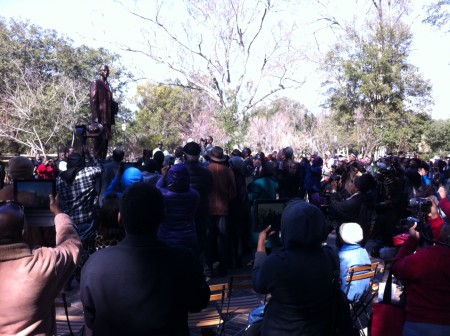
Unveiling of Denmark Vesey Monument in Hampton Park, image by Mary Battle, February 2014, Charleston, South Carolina.
Two weeks after the official unveiling of the Denmark Vesey monument in Charleston, South Carolina, the controversy surrounding the legacy of the insurrectionist freedman shows few signs of stopping.
The monument that now stands regally in Hampton Park proved to be a challenge for its planning committee, who found themselves enmeshed in negotiations that lasted almost two decades in order to bring about its completion. Yet, after eighteen years, a statue in commemoration of Denmark Vesey, the freedman who in 1822 allegedly plotted a slave insurrection that he paid for with his life, has finally been erected in the city. Ironically, Vesey’s likeness (or a representation thereof—since no drawing of him exists) has been placed within walking distance of the very institution that was founded to quell future slave rebellions: South Carolina’s lone “military college,” The Citadel.
One hundred and ninety two years after Vesey’s failed insurrection, this politically charged event continues to be met with accusations of Vesey’s alleged terrorism.
In 2010, a columnist for the Charleston City Paper, wrote a piece entitled “Denmark Vesey Was a Terrorist,” where he compared Denmark Vesey’s uprising to Osama bin Laden’s 9/11 attacks and Harry Truman’s decision to drop the atomic bomb over Japanese cities. “Despite his bloodlust,” the author writes, “Vesey remains a hero to civil rights activists.”
An editorial in the February 24th edition of Charleston’s Post and Courier accused the local newspaper of “rewriting history” in its alleged bias in favor of Vesey and the new monument built in his honor. “Contrary to this slanted story,” the editorialist writes, “Vesey was no heroic figure battling for education and freedom, but was well-known in the community as a brutal and violent man obsessed with vengeance. In real life he got the monument he deserved—the hangman’s scaffold.”
The controversy has reached a national stage within recent weeks with historian Douglas R. Egerton writing an editorial piece in the New York Times on Vesey entitled “Abolitionist or Terrorist?” Calling Vesey a terrorist, Egerton argues, is a difficult judgment call to make in light of the horrors of the institution of slavery. “Critics of the Vesey statue,” he notes, “may not care for his methods (even though their city bristles with monuments and statues of men who picked up a gun to fight for slavery in 1861). But they need to acknowledge that his views were shaped by the whip.”
Nearly two hundred years after the death of Denmark Vesey, his legacy continues to divide South Carolinians, southerners, and Americans. Whether you believe Vesey is a heroic abolitionist or a brutal terrorist (or you are somewhere in between), it is clear that this contentious dialogue will not be ending any time soon. As long as the statue of John C. Calhoun in Charleston’s Marion Square is met with reverence, Denmark Vesey’s stand in Hampton Park will be met with equal disdain.
Beth Gniewek
M.A. Candidate
College of Charleston-Citadel Joint M.A. History Program


